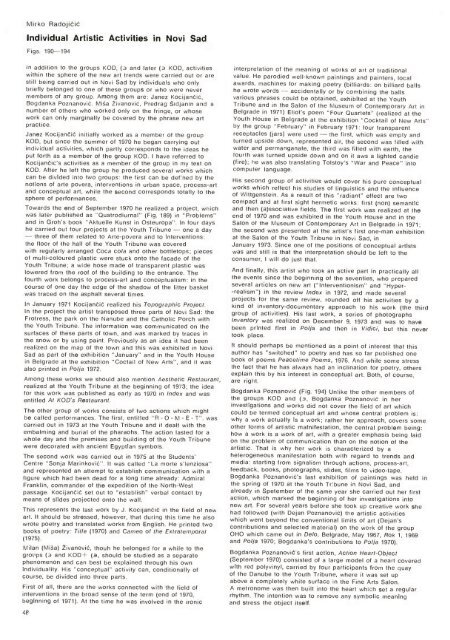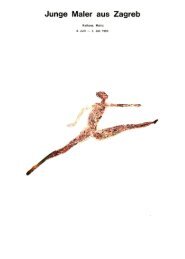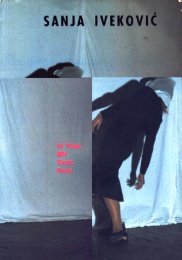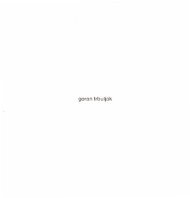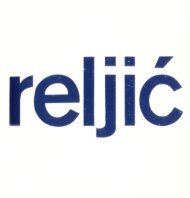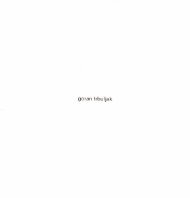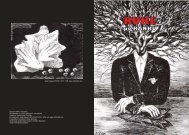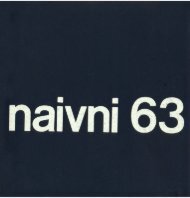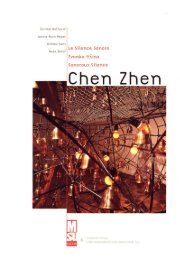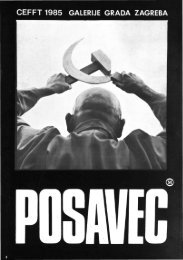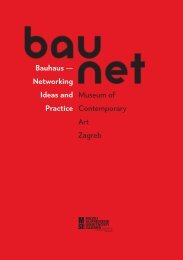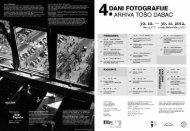The New Art Practice in Yugoslavia, 1966-1978
The New Art Practice in Yugoslavia, 1966-1978
The New Art Practice in Yugoslavia, 1966-1978
- TAGS
- practice
- yugoslavia
- www.msu.hr
Create successful ePaper yourself
Turn your PDF publications into a flip-book with our unique Google optimized e-Paper software.
Mirko RadojIi<br />
Individual <strong>Art</strong>istic Activities <strong>in</strong> Novi Sad<br />
Figs 190--194<br />
In addition to the groups KOD, (a and later (3 KOD, activities<br />
with<strong>in</strong> the sphere of the new art trends were carried out or are<br />
still be<strong>in</strong>g carried out <strong>in</strong> Novi Sad by <strong>in</strong>dividuals who only<br />
briefly belonged to one of these groups or who were never<br />
members of any group. Among them are: Janez Kocijani,<br />
Bogdanka Poznanovi. MiAa Zivanovi, Predrag idjan<strong>in</strong> and a<br />
number of others who worked only on the fr<strong>in</strong>ge, or whose<br />
work can only marg<strong>in</strong>ally be covered by the phrase new art<br />
practice.<br />
Janez Kocijani <strong>in</strong>itially worked as a member of the group<br />
KOD, but s<strong>in</strong>ce the summer of 1970 he began carry<strong>in</strong>g out<br />
<strong>in</strong>dividual activities, which partly corresponds to the ideas he<br />
put forth as a member of the group KOD. I have referred to<br />
Kocijani's activities as a member of the group <strong>in</strong> my text on<br />
KOD. After he left the group he produced several works which<br />
can be divided <strong>in</strong>to two groups: the first can be derned by the<br />
notions of arte povera, <strong>in</strong>terventions <strong>in</strong> urban space, process-art<br />
and conceptual art, while the second corresponds totally to the<br />
sphere of performances.<br />
Towards the end of September 1970 he realized a project, which<br />
was later published as "Quatrodiurnal" (Fig. 189) <strong>in</strong> "Problems"<br />
and <strong>in</strong> Groh's book "Aktuelle Kunst <strong>in</strong> Osteuropa". In four days<br />
he carried out four projects at the Youth Tribune one a day<br />
three of them related to <strong>Art</strong>e-povera and to <strong>in</strong>terventions:<br />
the floor of the hall of the Youth Tribune was covered<br />
with regularly arranged Coca cola and other bottletops; pieces<br />
of multi-coloured plastic were stuck onto the facade of the<br />
Youth Tribune: a wide hose made of transparent plastic was<br />
lowered from the roof of the build<strong>in</strong>g to the entrance. <strong>The</strong><br />
fourth work belongs to process-art and conceptualism: <strong>in</strong> the<br />
course of one day the edge of the shadow of the litter basket<br />
was traced on the asphalt several times.<br />
In January 1971 Kocijani realized his Topographic Project.<br />
In the project the artist transposed three parts of Novi Sad: the<br />
Frotress, the park on the Nanube and the Catholic Porch with<br />
the Youth Tribune. <strong>The</strong> <strong>in</strong>formation was communicated on the<br />
surfaces of these parts of town, and was marked by traces <strong>in</strong><br />
the snow or by us<strong>in</strong>g pa<strong>in</strong>t. Previously as an idea it had been<br />
realized on the map of the town and this was exhibited <strong>in</strong> Novi<br />
Sad as part of the exhibition "January" and <strong>in</strong> the Youth House<br />
<strong>in</strong> Belgrade at the exhibition "Coctail of <strong>New</strong> <strong>Art</strong>s", and it was<br />
also pr<strong>in</strong>ted <strong>in</strong> Polja 1972.<br />
Among these works we should also mention Aesthetic Restaurant,<br />
realized at the Youth Tribune at the beg<strong>in</strong>n<strong>in</strong>g of 1973: the idea<br />
for this work was published as early as 1970 <strong>in</strong> Index and was<br />
entitled At KOD's Restaurant.<br />
<strong>The</strong> other group of works consists of two actions which might<br />
be called performances. <strong>The</strong> first, entitled "R - 0 - M - E - T", was<br />
carried out <strong>in</strong> 1973 at the Youth Tribune and it dealt with the<br />
embalm<strong>in</strong>g and burial of the pharaohs. <strong>The</strong> action lasted for a<br />
whole day and the premises and build<strong>in</strong>g of the Youth Tribune<br />
were decorated with ancient Egyptian symbols.<br />
<strong>The</strong> second work was carried out <strong>in</strong> 1975 at the Students'<br />
Centre "Sonja Mar<strong>in</strong>kovi". It was called "La morte slenziosa"<br />
and represented an attempt to establish communication with a<br />
figure which had been dead for a long time already: Admiral<br />
Frankl<strong>in</strong>. commander of the expedition of the North-West<br />
passage. Kocijani set out to "establish" verbal contact by<br />
means of slides projected onto the wall.<br />
This represents the last work by J. Kocijani <strong>in</strong> the field of new<br />
art. It should be stressed, however, that dur<strong>in</strong>g this time he also<br />
wrote poetry and translated works from English. He pr<strong>in</strong>ted two<br />
books of poetry: Title (1970) and Cameo of the Extratemporal<br />
(1975).<br />
Milan (MiAa) Zivanovi, thouh he belonged for a while to the<br />
grovps (:, and KOD f- (:), should be studied as a separate<br />
phenomenon and can best be expla<strong>in</strong>ed through his own<br />
<strong>in</strong>dividuality. His "conceptual" activity can, conditionally of<br />
course, be divided <strong>in</strong>to three parts.<br />
First of all, there are the works connected with the field of<br />
<strong>in</strong>terventions <strong>in</strong> the broad sense of the term (end of 1970,<br />
beg<strong>in</strong>n<strong>in</strong>g of 19711. At the time he was <strong>in</strong>volved <strong>in</strong> the ironic<br />
4E<br />
<strong>in</strong>terpretation of the mean<strong>in</strong>g of works of art of traditional<br />
value. He parodied well-known pa<strong>in</strong>t<strong>in</strong>gs and pa<strong>in</strong>ters, local<br />
awards, mach<strong>in</strong>es for mak<strong>in</strong>g poetry (billiards: on billiard balls<br />
he wrote words accidentally or by comb<strong>in</strong><strong>in</strong>g the balls<br />
various phrases could be obta<strong>in</strong>ed, exhibited at the Youth<br />
Tribune and <strong>in</strong> the Salon of the Museum of Contemporary <strong>Art</strong> <strong>in</strong><br />
Belgrade <strong>in</strong> 1971) Eliot's poem "Four Quartets" (realized at the<br />
Youth House <strong>in</strong> Belgrade at the exhibition "Cocktail of <strong>New</strong> <strong>Art</strong>s"<br />
by the group "February" <strong>in</strong> February 1971: four transparent<br />
receptacles (jars) were used the first, which was empty and<br />
turned upside down, represented air, the second was filled with<br />
water and permanganate, the third was filled with earth, the<br />
fourth was turned upside down and on it aws a lighted candie<br />
(fire); he was also translat<strong>in</strong>g Tolstoy's "War and Peace" <strong>in</strong>to<br />
computer language.<br />
His second group of activities would cover his pure conceptual<br />
works which reflect his studies of l<strong>in</strong>guistics and the <strong>in</strong>fluence<br />
of Wittgenste<strong>in</strong>. As a result of this "radiant" effect are two<br />
compact and at first sight hermetic works: first (non) semantic<br />
and then (a)ssociative fields. <strong>The</strong> first work was realized at the<br />
end of 1970 and was exhibited <strong>in</strong> the Youth House and <strong>in</strong> the<br />
Salon of the Museum of Contemporary <strong>Art</strong> <strong>in</strong> Belgrade <strong>in</strong> 1971;<br />
the second was presented at the artist's first one-man exhibition<br />
at the Salon of the Youth Tribune <strong>in</strong> Novi Sad. <strong>in</strong><br />
January 1973. S<strong>in</strong>ce one of the positions of conceptual artists<br />
was and still is that the <strong>in</strong>terpretation should be left to the<br />
consumer, I will do just that.<br />
And f<strong>in</strong>ally, this artist who took an active part <strong>in</strong> practically all<br />
the events s<strong>in</strong>ce the beg<strong>in</strong>n<strong>in</strong>g of the seventies, who prepared<br />
several articles on new art ("Interventionism" and "Hyper-<br />
-realism") <strong>in</strong> the review Index <strong>in</strong> 1972, and made several<br />
projects for the same review, rounded off his activities by a<br />
k<strong>in</strong>d of <strong>in</strong>ventory-documentary approach to his work (the third<br />
group of activities). His last work, a series of photographs<br />
Inventory was realized on December 9, 1973 and was to have<br />
been pr<strong>in</strong>ted first <strong>in</strong> Polja and then <strong>in</strong> Vidici, but this never<br />
took place.<br />
It should perhaps be mentioned as a po<strong>in</strong>t of <strong>in</strong>terest that this<br />
author has "switched" to poetry and has so far published one<br />
book of poems Peacetime Poems, 1976. And while some stress<br />
the fact that he has always had an <strong>in</strong>cl<strong>in</strong>ation for poetry, others<br />
expla<strong>in</strong> this by his <strong>in</strong>terest <strong>in</strong> conceptual art. Both, of course,<br />
are right.<br />
Bogdanka Poznanovi (Fig. 194) Unlike the other members of<br />
the groups ROD and (a, Bogdanka Poznanovi <strong>in</strong> her<br />
<strong>in</strong>vestigations and works did not cover the field of art which<br />
could be termed conceptual art and whose central problem is:<br />
why a work actually is a work; rather her approach, covers some<br />
other forms of artistic mafnifestation, the central problem be<strong>in</strong>g:<br />
how a work is a work of art, with a greater emphasis be<strong>in</strong>g laid<br />
on the problem of communication than on the notion of the<br />
artistic. That is why her work is characterized by a<br />
heterogeneous manifestation both with regard to trends and<br />
media: start<strong>in</strong>g from signalism through actions, process-art,<br />
feedback, books, photographs, slides, films to video-tape.<br />
Bogdanka Poznanovi's last exhibition of pa<strong>in</strong>t<strong>in</strong>gs was held <strong>in</strong><br />
the spr<strong>in</strong>g of 1970 at the Youth Tr.bune <strong>in</strong> Novi Sad, and<br />
already <strong>in</strong> Spetember of the same year she carried out her first<br />
action, which marked the beg<strong>in</strong>n<strong>in</strong>g of her <strong>in</strong>vestigations <strong>in</strong>to<br />
new art. For several years before she took up creative work she<br />
had followed (with Dejan Poznanovi) the artistic activities<br />
which went beyond the conventional limits of art (Dejan's<br />
contributions and selected material) on the work of the group<br />
OHO which came out <strong>in</strong> De/o, Belgrade, May 1967, Rok 1, 1969<br />
and Polja 1970: Bogdanka's contributions to Polja 1970).<br />
Bogdanka Poznanovi's first action, Action Heart-Object<br />
(September 1970) consisted of a large model of a heart covered<br />
with red polyv<strong>in</strong>yl, carried by four participants from the quay<br />
of the Danube to the Youth Tribune, where it was set up<br />
above a completely white surface <strong>in</strong> the F<strong>in</strong>e <strong>Art</strong>s Salon.<br />
A metronome was then built <strong>in</strong>to the heart which set a regular<br />
rhythm. <strong>The</strong> <strong>in</strong>tention was to remove any symbolic mean<strong>in</strong>g<br />
and stress the object itself.


